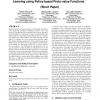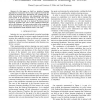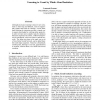688 search results - page 8 / 138 » Using reinforcement learning to adapt an imitation task |
COST
2009
Springer
13 years 5 months ago
2009
Springer
Synchrony is claimed by psychology as a crucial parameter of any social interaction: to give to human a feeling of natural interaction, a feeling of agency [17], an agent must be a...
ICMLA
2003
13 years 9 months ago
2003
This work represents the first step towards a task library system in the reinforcement learning domain. Task libraries could be useful in speeding up the learning of new tasks th...
ATAL
2008
Springer
13 years 9 months ago
2008
Springer
Reinforcement Learning research is traditionally devoted to solve single-task problems. Therefore, anytime a new task is faced, learning must be restarted from scratch. Recently, ...
IROS
2007
IEEE
14 years 1 months ago
2007
IEEE
— In this paper we build an imitation learning algorithm for a humanoid robot on top of a general world model provided by learned object affordances. We consider that the robot h...
IJCAI
2007
13 years 9 months ago
2007
Although necessary, learning to discover new solutions is often long and difficult, even for supposedly simple tasks such as counting. On the other hand, learning by imitation pr...



